First of all, we must talk about Giorgio Vasari (1511-1574) and remember his dual vocation. He was an authentic painter, a relative of the much older Signorelli, a full-time worker, a quick and tireless draughtsman, a steady and mathematical eye in architecture, and the creator of magnificent urban settings. To this manifold dedication in the world of forms he associated, as a second vocation, a vast capacity for investigation of the phenomena of art, so much so that it led him to a comprehensive analysis of the centuries recent to him and the phenomena coeval with him, pouring into it a serious endowment as a historical collector and a brilliant faculty as a writer. To give order to the prospection of so much matter he chose the system of Lives already tried in ancient Greece and renewed, again in Hellenic language, by Plutarch in the first century A.D. in a fully Roman environment. He avoided, moreover, the parallel coupling of individual personalities and set himself a viable chronology, albeit with many juxtapositions, and with geographical choices that would be helpful in understanding the various stylistic schools. Here it was that from his research, from his encounters, from tramando and more proximate testimonies, from his travels, from direct observations of works and from other sources came the Lives of the most excellent painters, sculptors and architects, drafted as biographies but contempered by historical notes, technical observations, important evaluations, and even by infiorative anecdotes that are not always credible. The first edition, called torrentiniana came out with extraordinary success in 1550 and prompted him to valuable expansions until the 1568 Giuntina edition, which also emphatically earned him the title of Poet.
This premise serves us to emphasize Vasari’s knowledge of a universe of authors that impressed even in his own day, and which remains as the first indispensable mirror of a comparative history of Italian art. Giorgio aretino’s critical lume is constituted by a selectivity that has a textual spillover of relevant effectiveness, so much so that the direct quotations that are grasped from his prose are still largely splendid and decisive today. The second part of the Lives ends precisely with Luca Signorelli’s death, which ideally delivers the last perfection of art to those who followed. The third part is therefore dedicated to those excellent masters who were able to rise and lead themselves to the supreme perfection. It opens in Lombardy with lavvincente vita di Leonardo, and then passes by sensory affinity to that of Giorgione da Castefranco. After this the author makes a confession and warns that he does not want to leave Lombardy without having touched the excellent and beautiful genius of Antonio da Correggio: in fact, Vasari’s encounter with lAllegri turns out to be a jolt, almost a syncopation of stupendous marvel that holds back the most feeble commentator and stops him before an absolute, unpredictable phenomenon, where the cause of this great finder of any difficulty is unknown to him. Vasari tries to propose to the reader an attempt to compare Correggio with the greats but abruptly resolves the case with a hyperbolic sentence: Tengasi pur per certo che nessuno meglio di lui toccò i colori, né con maggior vaghezza o con più rilievo alcun artefice dipinse meglio di lui, tanto era la morbidezza delle carni che egli faceva, e la grazia con che e finiva i suoi lavori. A statement of supremacy that leaves one astonished to this day, and well we know who the greats of the mid-Renaissance were! The Tuscan painter-writer then harps on the whole of Antonio’s uncertain professional life on phrases above the stave (as they say) stating that he achieved perfection in fresco and oil works with infinite praise and honor (fig. 1). He credits him with being the first to practice the modern manner in Lombardy. He then leans particularly-he who was of the trade-on the hairs so graceful in color and with finished cleanliness drawn and conducted that better than those cannot be seen (fig. 2). Finally he leaves his pen almost suspended in the sky and proclaims: but because among the excellent men of our art every thing that is seen of his own is admired as divine, I will not relax any longer.
We now know that Correggio received from painters and scholars in the 17th and 18th centuries, all the way to Piccio and Courbet, considerations and incenses of moved recognition as a master of space, color, venality, fragrant naturalism, visual poetry and sentiment. Certain more attentive critics in the twentieth century have contributed to his growing appreciation as the Master of Domes and Graces: mention especially of Roberto Longhi and Cecil Gould, and then the contribution of David Alan Brown (1973) who rightly placed him as the lassuntore of Leonardo’s word and the lofty continuer of his legacy. For his part, David Ekserdjian in his celebrated monograph (1997) hinged Correggio’s lopus with order and rightness. Eugenio Riccòmini, Lucia Fornari Schianchi and Roberto Tassi have greatly expanded the understanding, as have other contemporary scholars. But the new millennium, in addition to more advanced studies of documents and works, has reserved a surprise of an extremely modern nature: spectacular, in its own way sympathetic and full of clangour. The big bang came from none other than Dario Fo, a highly fecund author, overwhelming man of the theater, always imaginative and scotching, but (let us not forget) trained at the Brera Academy of Fine Arts according to his vocation as a brilliant painter and draftsman. During a carnival in Fano he discovered, at a familiar site, a tablet with a sublime face, tarnished by time but enchanting in grace and sweetness (fig. 3); the elderly owners declared with simplicity that it was a gift that had come from England for one of their grandfathers, always assigned to Correggio, and locchio frecciante of the national Dario enthusiastically confirmed it; not only that, but he took the small wood with him and personally brought it to the friend Pinin Brambilla Barcilon, the prodigious restorer engaged in the painstaking illimitudine of the restoration of Leonardo’s Last Supper.
Pinin was in turn fascinated by the artist’s hand and devoted to the painting a loving care of extreme wisdom (2004): thus all the trepidation of the face of the SantAgata concerning on the pate of martyrdom her severed breasts returned to effuse that mystical light that is the pictorial prodigy of Correggio’s visions (fig. 4). In the restoration paper, Brambilla Barcilon emphasizes the specific mastery of the artist by saying that the woman’s face and hair are characterized by an extremely meticulous and refined execution, recalling the process through the constant overlapping of thin transparent veils and how the face in particular came out with its softness.
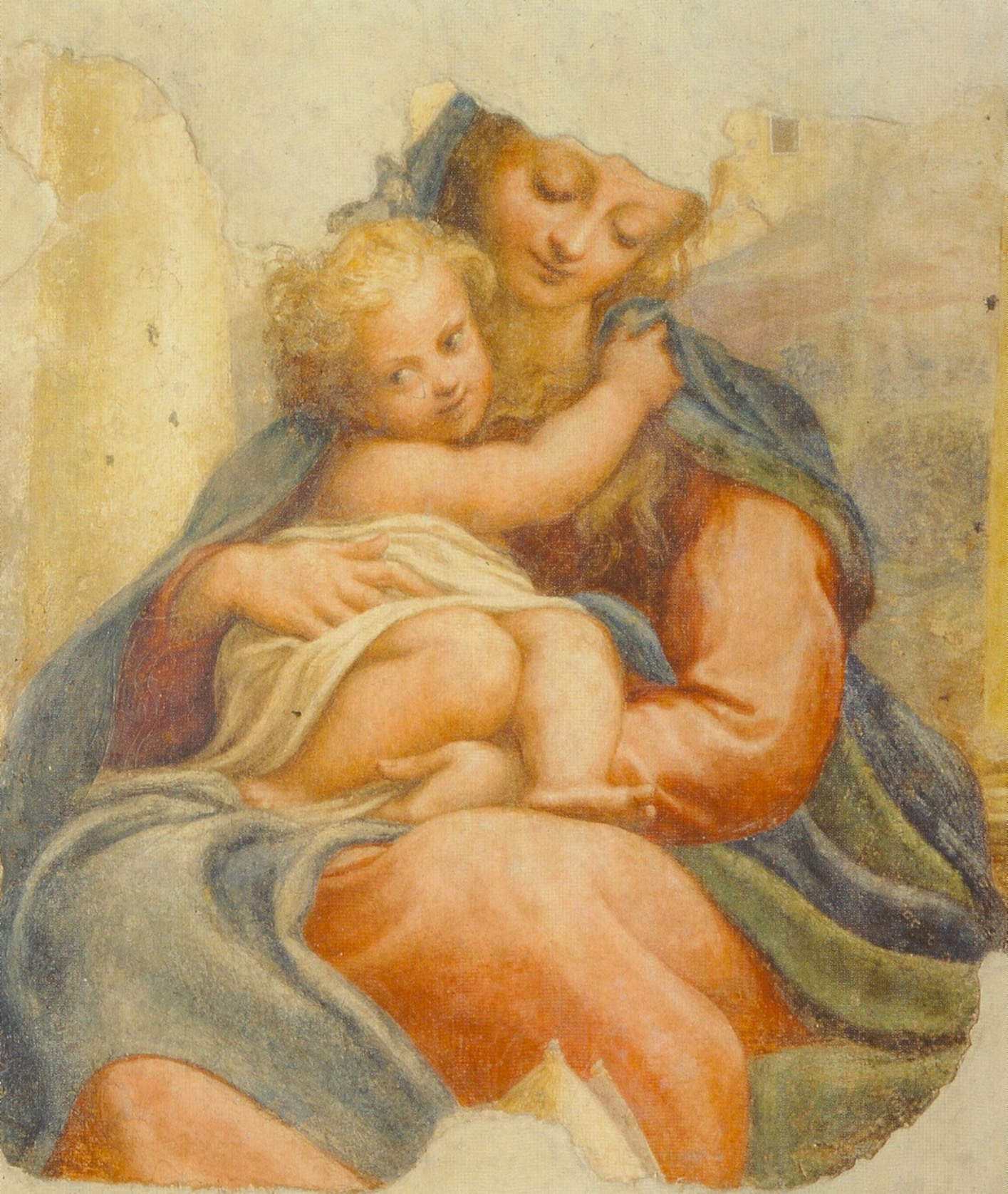 |
| 1. The Madonna of the Staircase. A fresco partially saved by the will of the people all of Parma from the demolition of the city gate on which it stood. Vasari declares it a stupendous thing to behold, which has received from strangers and wayfarers infinite praise and wonder. As execution we are between 1523 and 1524 after Correggio had brought the family to Parma and when he began to portray a more gently rounded and luminous type of female face. |
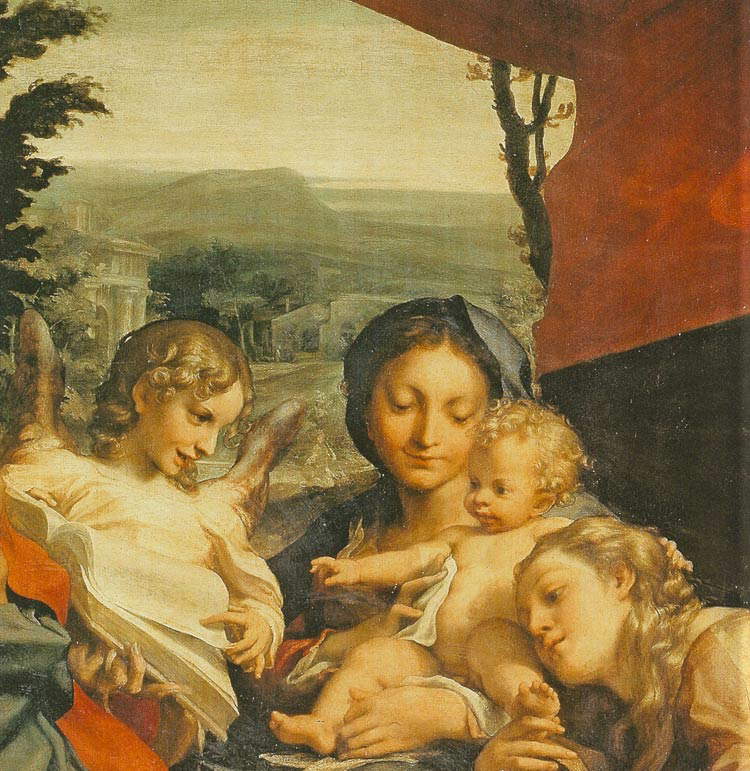 |
| 2. The hair in Correggio’s Day Figures, which Vasari saw in the Church of SantAntonio in Parma. The Tuscan painter was enchanted several times before the very fine parading of theAllegri’s harmonious hair, where ease and difficulty are admirably accompanied, and for the execution of which he declares that all painters owe him eternally. |
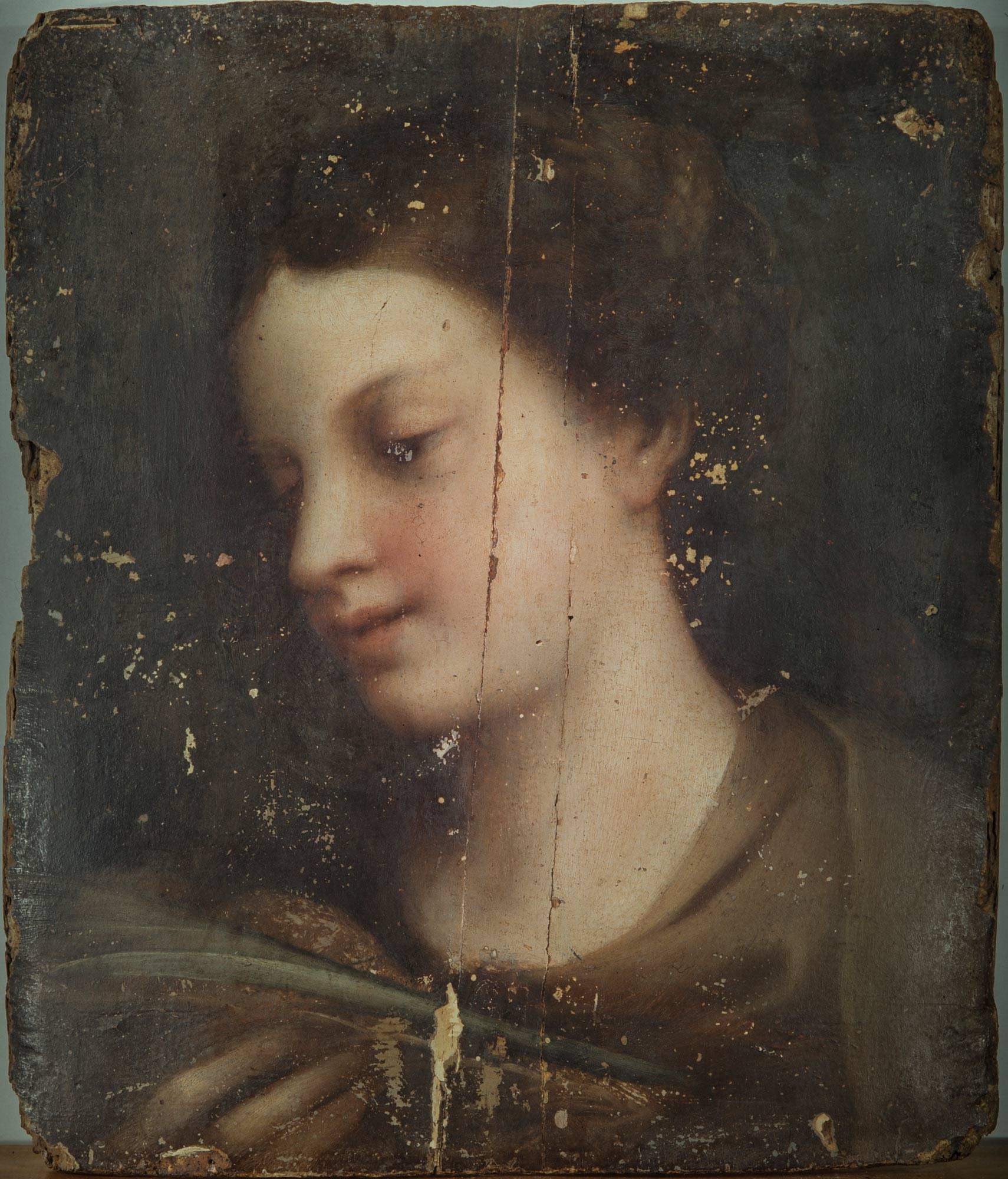 |
| The tablet with the head and bust of SantAgata, at the time when Dario Fo saw it at a family in Fano (2004). The travails of the past centuries are evident there. On the other hand, the family had jealously preserved the memory of the return from England at the end of the nineteenth century of this small painting, since then known as a work by Correggio. Dario, an artist himself, was enthusiastic about it and procured a restoration of the highest class. |
 |
| 4. Antonio Allegri known as Correggio, SantAgata (1523-1524; oil on panel 29 x 34; Museo di Correggio). The result of Pinin Brambilla Barcilon’s painstaking intervention restored, in the words of the thaumaturgic restorer, the tender softness of the face and the wonder of the hair-all qualities peculiar to Allegri’s divine hand. The Saint here appears in a mystical vision, gazing at the two breasts that were cut off from her, protagonists of her martyrdom and symbols of her glory. |
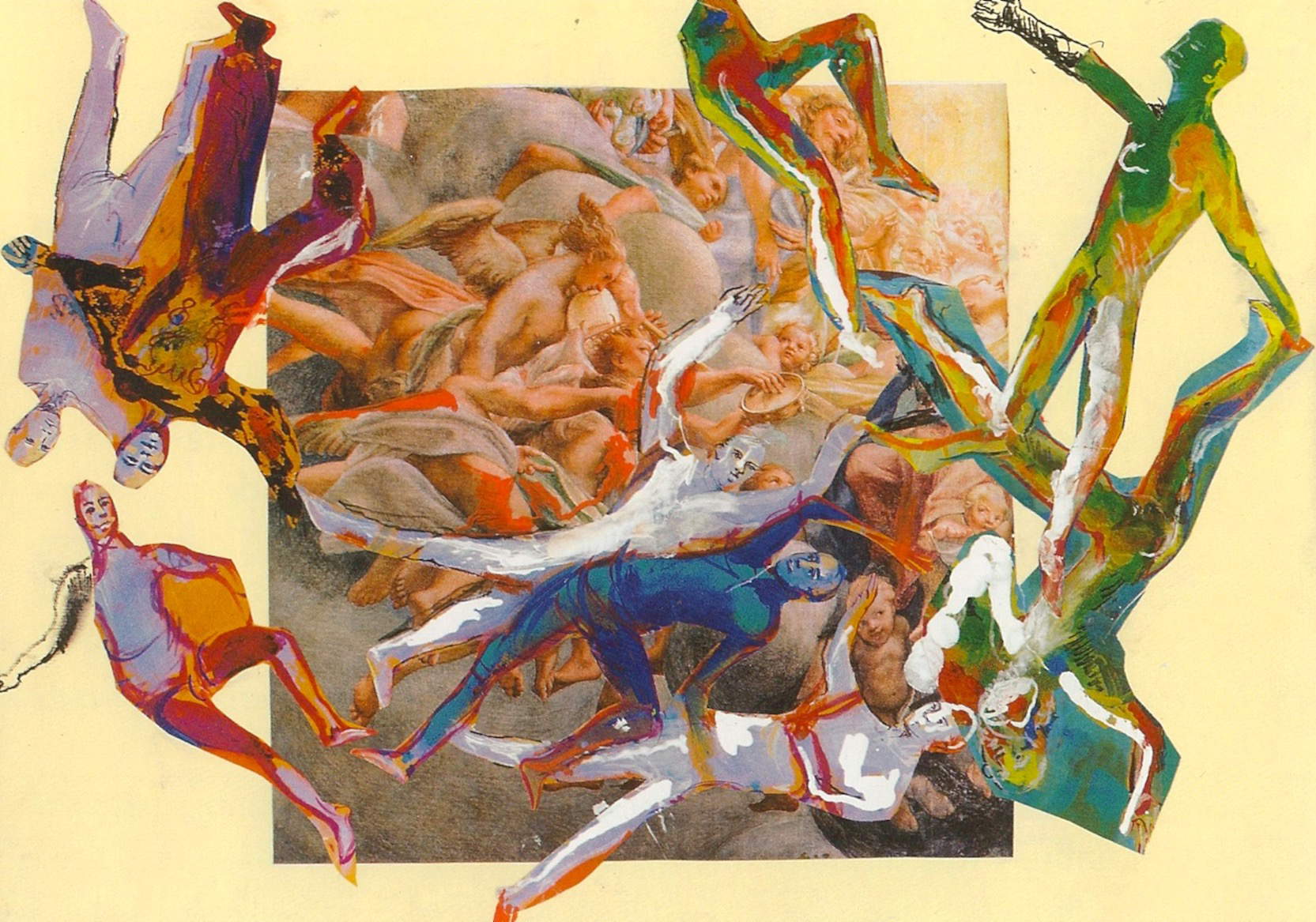 |
| 5. Dario Fo, Paradise, with Correggio. A pastiche from Dario Fo’s book, published in 2010, in which the Nobel laureate sings the heavenly ballad from his own lips. |
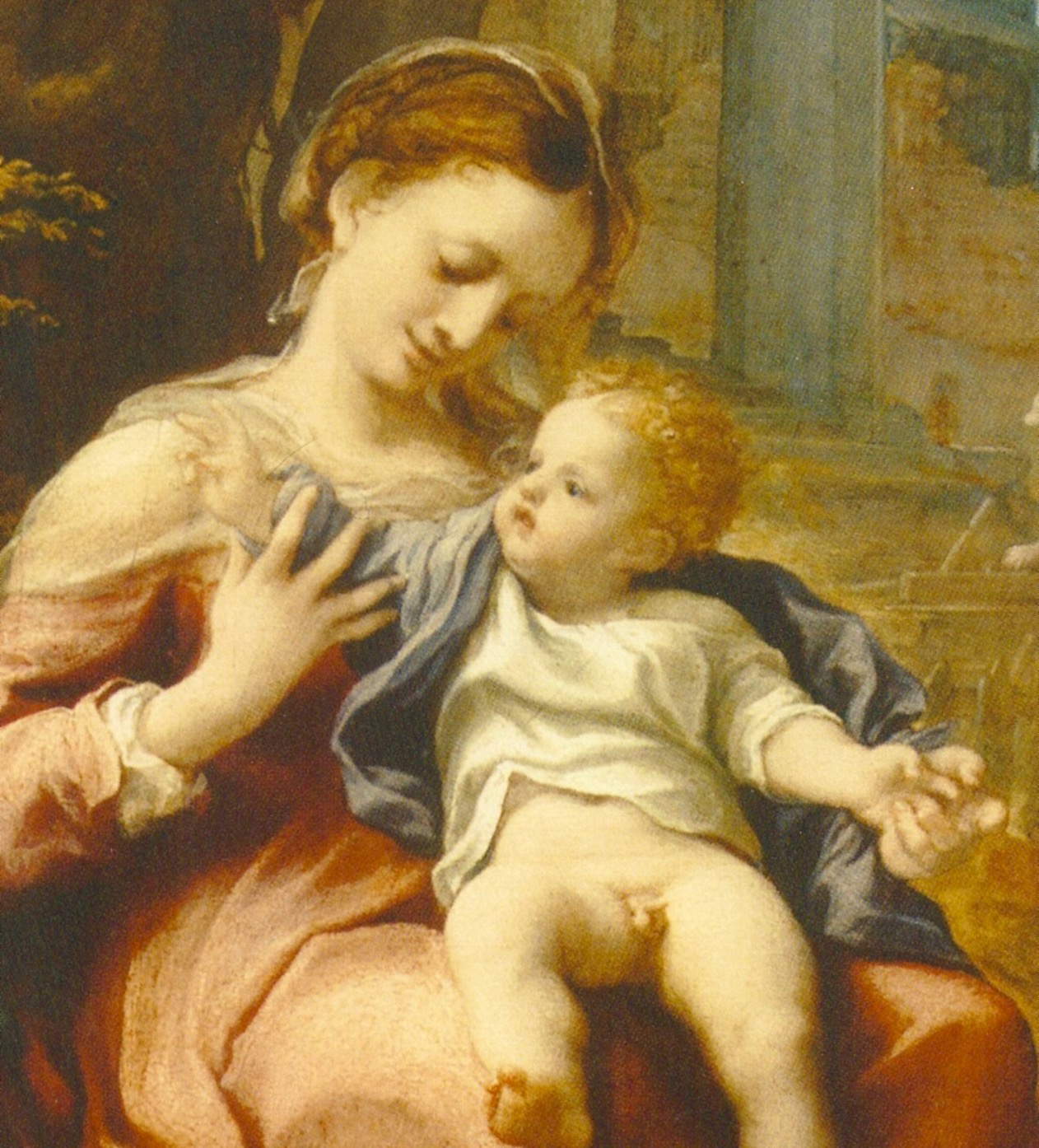 |
| 6. Correggio, Madonna of the Basket (oil on panel, 33 x 25 cm; London, National Gallery). This panel is published by Dario Fo as an example of Mary’s close resemblance to the SantAgata. A very obvious analogy. |
Dario Fo proclaimed that for him limmagine was the face of Jeronima (Girolama), the very young and beloved bride of Antonio Allegri. He expressed this declaration in an effervescent TV show and published it in an almost unbelievable book that he brought out shortly thereafter(Il Correggio che dipingeva appeso al cielo, 2010) (fig. 5) where appropriate comparisons appear (fig. 6) and where, with his own hand, the imaginative histrionic man wanted to see the kiss of Girolama and Antonio under the vaults of the dome of Parma Cathedral (fig. 7). Finally, the kaleidoscopic Nobel laureate even saw Jeronima in the paradise of the same dome, thus glorifying earthly love and heavenly love (fig. 8). To stick to the painterly development of the Emilian genius we must see, through examples, what female type he applied to his paintings in the early stage of his career (figs. 9 and 10).
But it is Pinin Brambilla’s last word (softness) that makes us surprisingly recapture that ancient awe of Vasari that he himself declares inexpressible (fig. 11). The painter from Arezzo in 1550 in Rome had befriended Girolamo da Carpi (from Ferrara, 1501-1556), his colleague and a talent of excellent caliber, who told him how in his youth he had been searching for a convincing model but could not find one among the known professionals of the time, until he happened to see Correggio’s Noli me tangere in Bologna. Such a sight urged him anxiously to Modena to admire in the house of Dr. Francesco Grillenzoni, a close friend of Correggio’s, an extraordinary painting, namely the Mystic Marriage of St. Catherine (c. 1524), which is now in the Louvre. It is worth quoting Vasari’s textual passage:having seen Christ in the form of an ortolan appearing to Mary Magdalene, worked so well and softly, as much as cannot be believed, it entered so much into the heart of Girolamo that manner, that not being enough for him to have portrayed that picture, he went to Modana to see the other works by the hand of Correggio, there where he arrived, besides being left in seeing them all full of wonder, one among the others made him astonished, and this was that great painting, which is a divine thing, in which is a Our Woman who has a Putto in her neck, who marries Saint Catherine, a Saint Bastiano, et other figures with airs of heads so beautiful, that they seem to have been made in paradise; nor is it possible to see the most beautiful hair, nor the most beautiful hands or other coloring more vague and natural. Vasari’s Liperbole (made in paradise) renders the measure of the incomparable admiration of the prince of the arts of drawing: a tribute never paid to any other in all his albeit very careful Lives.It is very important to remember that the identity of the author goes back at least two centuries. The painting’s direct link to Correggio is historical, although the painting’s silent return from England and hiding out with a secluded family has long eluded it from major critics. From March 15 to September 2, 2018, limmagine della SantAgata was the protagonist of a much-visited exhibition in Senigallia with accompanying Catalogue (Silvana 2018), receiving fervent reviews from national newspapers and major darte magazines. Alongside Eugenio Riccòmini, Carlo Bertelli, and Pier Paolo Mendogni, even the militant Federico Giannini wrote (Art and Dossier, May 2018): This is a work that determines the transition between the very high iconicity of Tuscan culture and the new immersion in the bodily trepidation that Correggio, as an extraordinary precursor, sought. After the replication of the exhibition in Correggio, with exquisite feminine wisdom Ilaria Baratta thus expressed herself: Correggio’s santAgata is a girl with the sweetest features, thoughtful, dense dumanity .she is beautiful: duna beauty that exudes love, lively participation, empathy with the subject and with the model, so much so that Dario Fo speculated that it could be a portrait of the painter’s young wife . Other critics, both Italian and foreign, have openly associated themselves with these judgments.
Why then the softness? Because it is the secret, the unspeakable charm, the inimitable signature of Correggio. A signature that, even on a technical level, is unobtainable and intrasportable from any other painter. It arouses the historical endless admiration on the Allegriani incarnates; it moves the throb of feelings when one lingers in contemplation on his nudes and children painted in full maturity; when one approaches the breaths of his smiles, and when everything invites one to grasp the vibrations of the hearts of his maidens: whether saints loved by God, or sweetest mothers, or mortals and nymphs welcomed into the ecstatic amplexes of myth. After Vasari, the term softness returns later in the centuries as an identifying stigma of Correggio by dellAlgarotti and Anton Raphael Mengs, who uses the synonym for tenderness, and is found at secular close in the serene scholarly report of Pinin Brambilla Barcilon. The fascinating result of Correggio’s bodies and faces, so inviting to the touch of caressing, surprised other restorers and diagnosticians who focused on the investigation of the pictorial preparations, which have always been distinctive elements of the great Masters. We could cite several published findings, but it will suffice for us to unify here various findings: dellAllegri’s preparations are very special and contain in suspension rare aventurines, cupric or dantimony, or of luminous mica: that is why light emerges and effuses from the bodies themselves. The face of the santAgata is a poignant example of this.
 |
| 7. Drawing by Dario Fo. Lescogitating and cheerful histrion thus imagines, in his own hand, a loving kiss of Antonio Allegri to his bride Jeronima, before ascending to the vaults of Parma Cathedral for the frescoes of the dome. |
 |
| 8. Correggio, detail from the frescoes of the dome of Parma Cathedral. Dario Fo, exploring the crowd of angels accompanying the Assumption of Mary to heaven in Correggio’s grandiose work, wants to glimpse among them the face of Jeronima. |
 |
| 9. Correggio, Madonna and Child with St. John (oil on canvas, 64 x 50 cm; Chicago. The Art Institute). We see here the typology of Correggio’s female face as the painter uses in his early phase, which also includes the altarpieces Madonna di San Francesco and Madonna di Albinea. These are barely elongated faces with fine features, thin lips, a sharp nose, and sharp, open brow arches. |
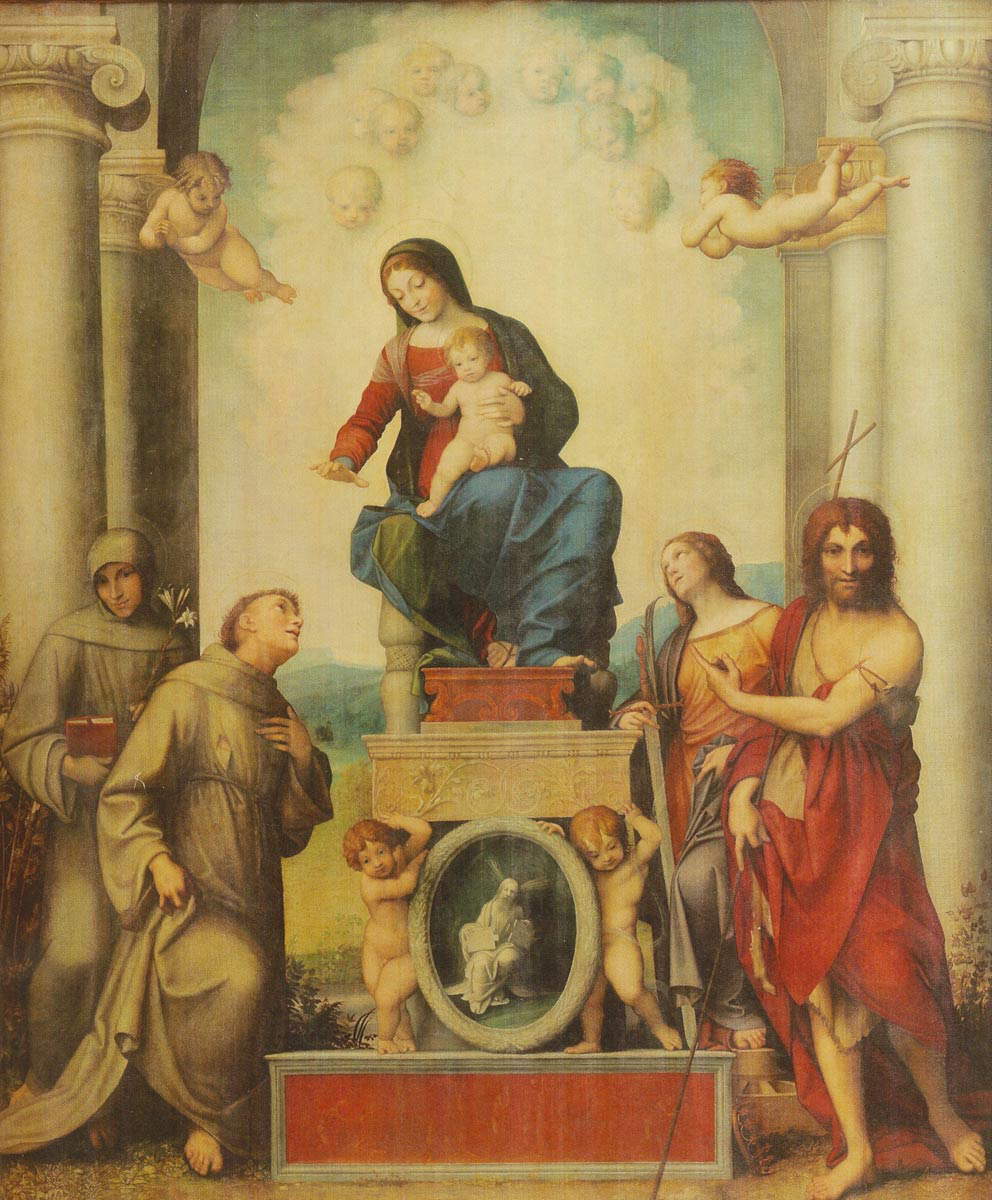 |
| 10. Correggio, Madonna of St. Francis, altarpiece (oil on panel, 299 x 245.5 cm; Dresden, Gemäldegalerie) |
 |
| 11. Correggio, SantAgata. Let us review Figure 4 in order to recall that Correggio between 1513 and 1514 addressed himself with vivid closeness to a new living model with a youthful face and a distinctive chin, portraying her with extreme care and with the use of those singularly studied preparations of hers, in order to bring out the light from the complexions themselves. At the same time the painter applies himself to communicating the thoughts of his characters: this, too, is an extremely important achievement. Here the Saint reveals that she has given herself to Christ through martyrdom; she communicates this with her gaze, and with her mouth that lets one perceive a sigh of life. |
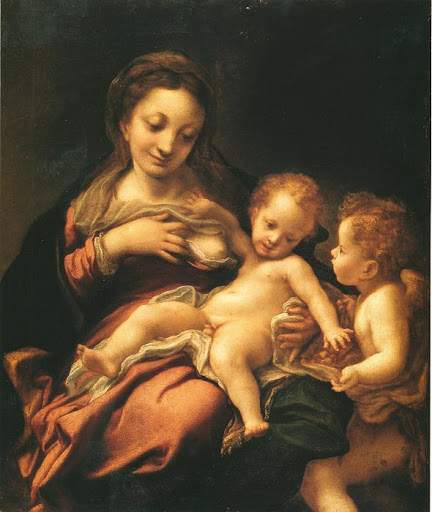 |
| 12. Correggio, Madonna of Milk (oil on Board, 68.5 x 56.8 cm; Budapest, Museum of Fine Arts). Youth, so lovingly cocooned by the model-bride, is here poured out by Antonio, a new father, on a divine Mother. Identical are her face and smile. |
The first scientific proof comes from the work itself: it is a portrait from life. It is a portrait from a living person, proof of its vital and communicative force where especially the shape of the chin and its relationship to the lips cannot be a manner invention. The model is evident, and she is a model fervently applied by Correggio in his works from at least 1524. She is inseparable from the two female figures in the Mystical Marriage in the Louvre (especially the Saint Catherine), the Madonna of the Basket, the Madonna of Budapest (Fig. 12), the Saint Catherine of Hampton Court (Fig. 13), and the Madonna of the Adoration in the Uffizi (Fig. 14). And it is here the time to consider again Vasari’s lincanto on the airs of heads made in paradise precisely on the Mystic Marriage of St. Catherine with figure of St. Sebastian, now constantly exhibited in the Louvre Museum (Fig. 15). It is the painting that triggered the admirer’s ideal lestasis, and for us it is the magnificent proof of Correggio’s attachment to a face that was able to enchant him through falling in love and tenderness.
It is incontrovertible that from the moment Correggio brings his bride and first child to Parma (1523), his female type becomes sweeter and more molten in the face, often and strongly recalling the morphology of SantAgata (Figs. 16 and 17): this up to the Madonna of the Bowl and up to the enchanting profile of the nymph Io, abandoned to the beatifying embrace of Jupiter (Fig. 18). The figure of santAgata thus turns out to be the prototype for the creation of the many other female figures of the maturity.
We have thus made a small discovery: we have found Correggio’s contemplated model, her secret love, desired and close, and we admire her beautiful Sisters.
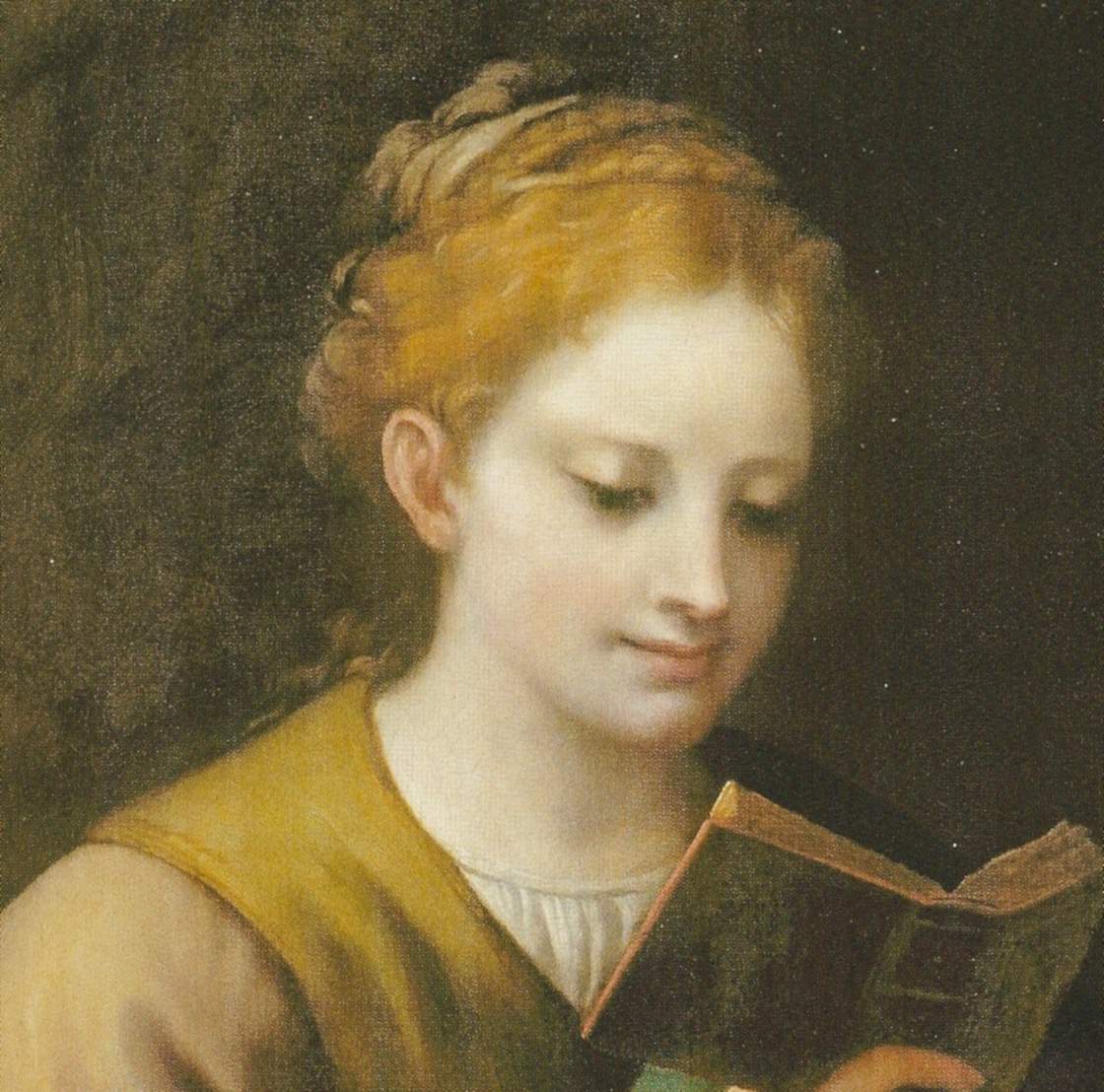 |
| 13. Correggio, Saint Catherine with Book (oil on canvas, 64.5 x 52.2 cm; Hampton Court Palace). The use of the same model as the SantAgata is evident. This, too, is a painting of soft, accurate tenderness. |
 |
| 14. Correggio, Madonna in Adoration of the Child (oil on canvas, 82 x 68.5 cm; Florence, Uffizi). SantAgata’s trepid profile reappears in this extraordinary adoration. |
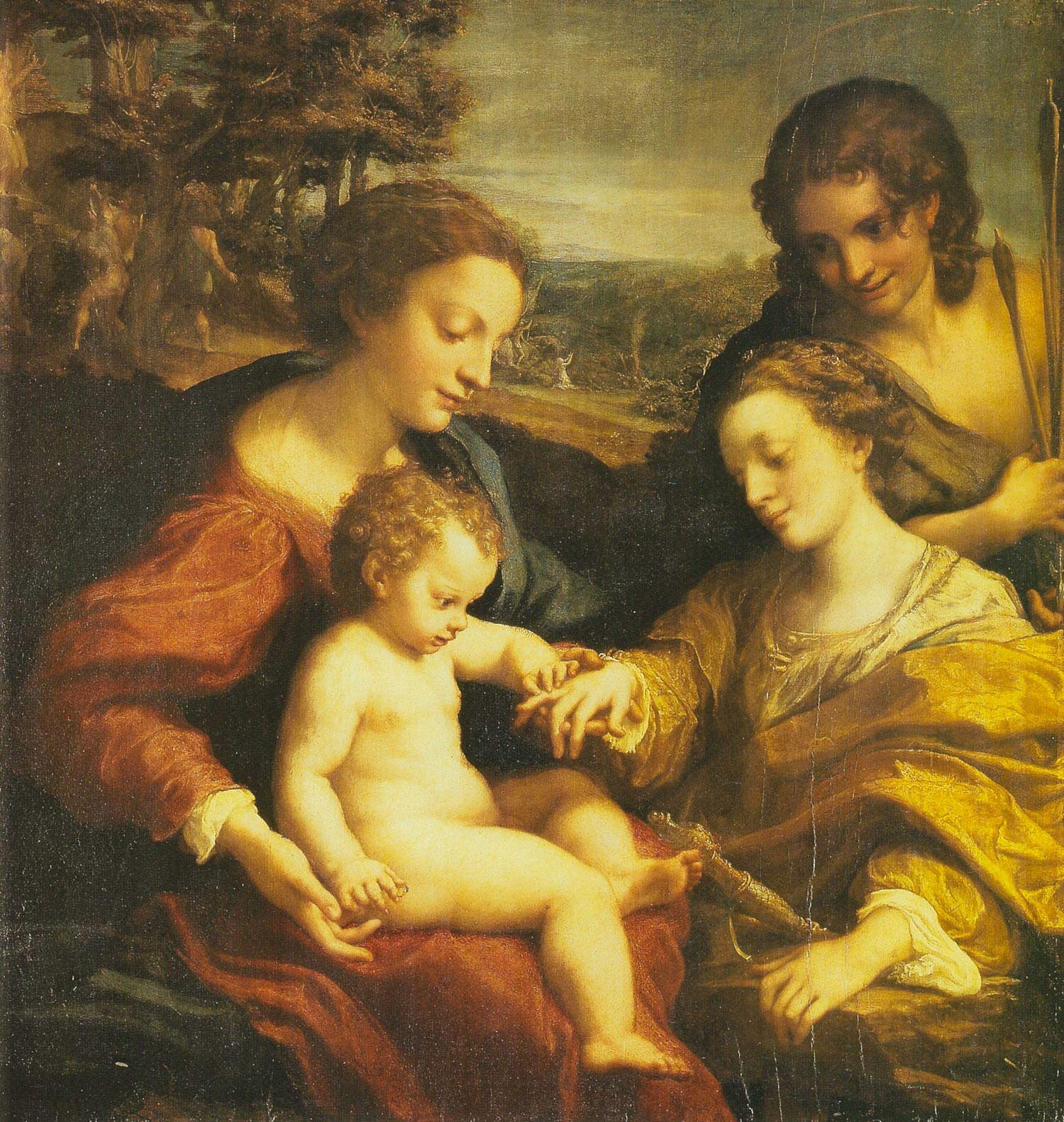 |
| 15. Correggio, Mystic Marriage of Saint Catherine with Figure of Saint Sebastian (oil on panel, 105 x 102 cm; Paris, Louvre Museum). This is the masterpiece that caused Vasari’s amazement. The two female figures in their faces appear as sisters and echo the female type we know so well. This panel, which was probably a family gift from Correggio to his friend Francesco Grillenzoni, gathers all the artist’s evident mastery but also all the intimacy of his soul. The substantial core of the painting lies not only in the intertwining of the hands but particularly in the intensity with which the eyes focus on the spousal event. We could define this vision, in which we participate so closely, as a high spiritual sweetness without human words. |
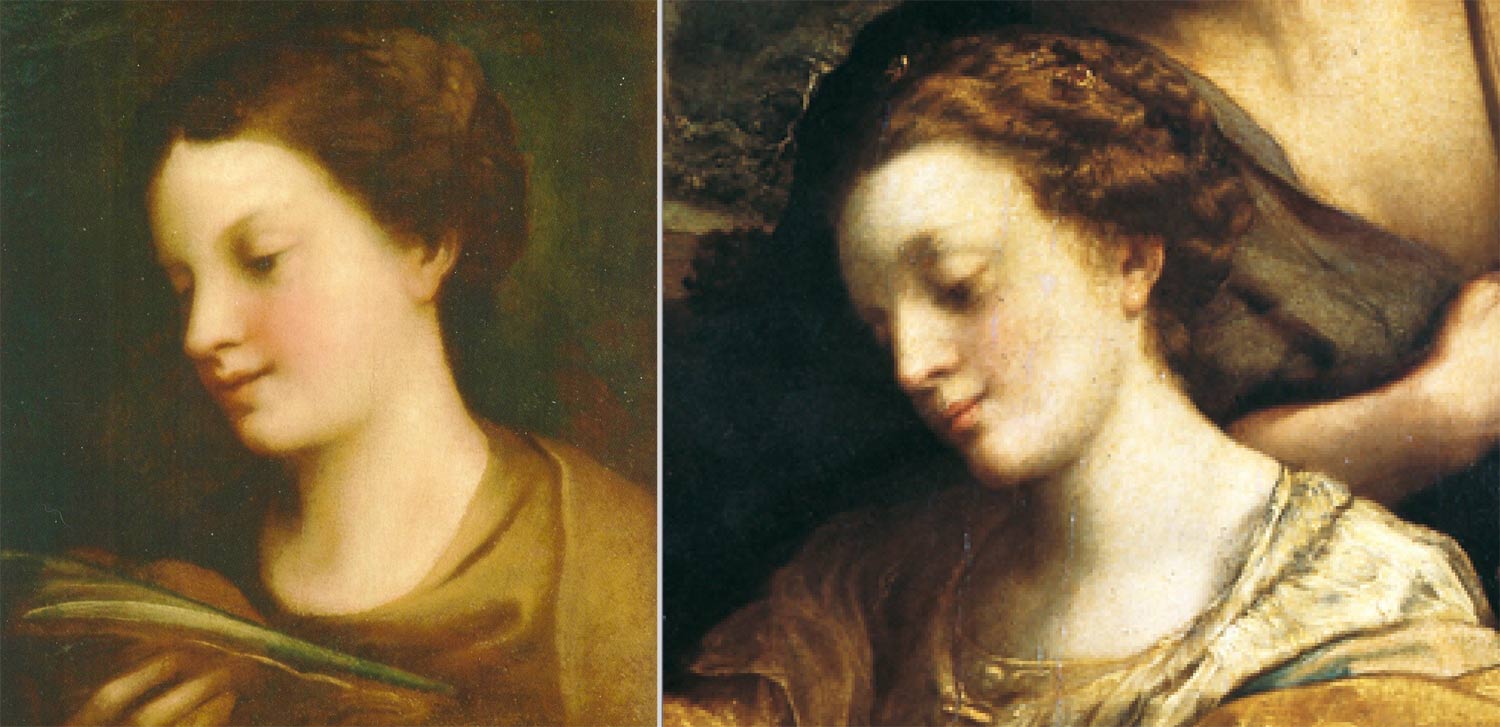 |
| 16. A comparison. The face of Saint Agatha and that of Saint Catherine in the Louvre. The similarity is touchable. The graphic relief of the two profiles is perfectly identical, superimposable. Of great importance is seeing how the SantAgata was executed freshly in front of the model, while the St. Catherine is more professionally elaborate and finished. |
 |
| 17. Another comparison, with the profile of the Madonna of the Marriage in the Louvre, in this case placed in counterpart to highlight the relationship, executive and affectionate. |
 |
| 18. Correggio, detail from the painting of Jupiter and Io, housed in the Kunsthistorisches Museum, Vienna. Here, too, the caressed face of the bride returns: it is a triumph of the female ideal of the fervid Antony. The happy abandonment of the nymph who offers herself to Jupiter’s supreme and desired embrace crowns, in the silence of the forest, the great Correggio’s love ideal. |
To deal with a work by Correggio requires above all the ability to identify with the artist’s soul and to have understood, with a long contemplative and reflective consonance, his ethical and spiritual character: that is, those reasons of the heart that accompanied him everywhere and allowed him marvelous pictorial openings always imbued with deep inner truths. This is how one can frame his own life: with his choices to shun the great centers and the Courts, with his refusal to professionalize his exceptional qualities in direct portraiture, in historical or illustrative subjects, in purely hedonistic themes. And altogether it is necessary to perceive that rich and profound theological culture that constantly imbued his thought: a culture of total Christian humanism, made festive by the global understanding of theffascinating beauty of the human body: the inconsumable wonder of the entire creation. Without the possession of this premise it would be useless to speak of Correggio’s works, each of which as Vasari says is believed to be a divine work.
Appears in the sharp space the luminous face of the young girl from Catania, with a noble and precious name, signifying purity devoted to holiness. The posture is classical, recorded on a gentle firmness emanating from the waist, where the head tilts slightly concerning a fatal memory of trying martyrdom-which she holds with her right hand within a light pàtera baccellata with shell lorlo, already indicative of perfection. Here we glimpse as a symbol her two breasts, which were cut off during the torments, but almost protected by the long sprig of the palm, a precise sign of a heroic choice to bear witness to Christ: a sign therefore holy and glorifying.
We are dealing with a subject of genuine mystical character, a meditation in heaven on what the virgin had to confess by faith and suffer in the final and decisive phase of her earthly life. A rare theme, if we are to agree, compared to many shrine images produced by painters small and large, fixated on the still figures and circumstantial attributes. An unfolding of the theme that only an artist bearer of a diversity that remains open on the chasm of the future, as RobertoTassi has written, could produce; an artist who has always started from the spirit and not from the iconography, and in all his work has opened for the future the most remote scotimenti of the souls. This in the land that hosted Leonardo, in the land of Lombardy.
Out of Agata’s barely opened lips comes that breath of sweetness that is typical of Correggio for outstretched femininity: it will be so for the Magdalene of the Mourning, for the Saint Flavia of the Martyrdom of the Four Saints, for the Venus of the Louvre, and finally for lamorosa nymph Io. And a breath that is caught emanating, a sigh of remembrance and life that is transformed into an intimate and eternal happiness, and that has the same lightness as the palpitation of the soul.
Now it is supremely necessary to concentrate in this subject, which is not a minor and marginal work of the great master, but a decisive document to understand what was happening in him as the source of inspiration, that is, how that quod intimius, quod profundius that was in his soul in front of a composition to be explicated, arose in a precise moment. Correggio in this sense is truly a heavenly prophet for that tuttuno that fuses the level of genius with linvention of language on each specific theme. It can be said that the SantAgata, executed with such spontaneity, is the key to understanding himself that Correggio offers us, of his creative implectio toward the figure.
Hence we can agree with Ilaria Baratta when she writes: Correggio’s SantAgata is indeed beautiful, duna beauty that exudes love, lively participation, empathy with the subject and with the model. Here, a beloved model! For Dario Fo it can only be Correggio’s young wife, Jeronima, married at the age of seventeen in the fall of 1520. A reality, indeed, that knows spaces of spiritual intensity, but which in truth is called to be anticipation and reverberation of the mystery with which it reveals itself, and at the same time unspeakably veils itself: and that is the transcendent mystery of love itself.
We return to the authentic character of Correggio that Vasari, though at a distance, had to grasp as preeminent-that is, he lived as a good Christian-and therefore we return to the Benedictine impregnation that is undeniable in our Antonio, for which always accompanies the sense of the sacred and makes the artist spontaneously bring reality itself back into a perfectly symbolic dimension.(symballein means to put things in harmonious relationship). Thus Jeronima’s face receives that special semantic vision that makes us grasp with sensory perception the invisible reality that lies above the highest intelligence. The regarding of her breasts, - the true precious stigma of femininity cruelly struck here - offers us the idea of a thought that is going through her mind: the loss of a part of herself and her giving herself to Christ. We are before a masterpiece of pictorial spirituality like few, all wrapped up in a single image of virginal face and mystical thought.
St. Basil, the dorient contemplator on the ineffable and inconsumably dense mystery of God’s beauty, says that in the admiration of heaven our head must be surrounded by a most sweet serene night. It seems that Correggio was well aware of this invitation since he surrounds the head of SantAgata with a tender vibrant darkness; in fact, as we have already recalled, the place of the meditation of the Catanese Virgin is ethereal, supersensible, where a light that is not astral but ideal prevails: a light almost gushing forth from Agata’s own sanctity, from her most pure soul.
This is a sensibility wholly exclusive to Correggio, which manages to transcend in the simplicity of form the distinction between sacred and non-sacred, in grace to the physicality that is the seat of life: such transcendence, so recommended by the Benedictine monastic vision in which Antonio was immersed (he had just been spiritually received into the religious family) justifies and opens for us the bodily enthusiasm of Dario Fo, always in tussle with the problems of faith. Here it is: Dario’s love for Jeronima, painted here, allows him to filter an eroticism rich in playfulness, already grasped in the Camera di San Paolo, and which he finds fragrant again in the nudes of the dome of San Giovanni and then in those, hailing and somersaulting, in the triumph of the Duomo. It is the holistic, total dimension of the SantAgata, between lived and prayer, between light divine quality and mystical nocturne, that only an exalted artist could touch.
Warning: the translation into English of the original Italian article was created using automatic tools. We undertake to review all articles, but we do not guarantee the total absence of inaccuracies in the translation due to the program. You can find the original by clicking on the ITA button. If you find any mistake,please contact us.